Submitted:
22 December 2023
Posted:
25 December 2023
Read the latest preprint version here
Abstract
Keywords:
1. Introduction
- A comprehensive investigation on several input parameters for Chla modeling, including all the 13 bands of the MSI onboard of Sentinel-2 constellation and 16 different spectral indexes.
- A comprehensive analysis and characterization of all the 149 tropical reservoirs extensively spread across the state of Ceará, located in the Brazilian semi-arid region.
- The usage of stepwise approach on parameters selection.
- The investigation of different machine learning paradigms for modeling Chla values.
- To fulfill the gap in the knowledge regarding the usage of the GMDH ML model for Chla modeling using remote sensed data and spectral indexes.
- To assess the performance of several machine learning paradigms applied to a vast region containing heterogeneous reservoirs.
2. Materials and Methods
2.1. Study site location
2.2. Water quality data
2.3. Sentinel-2 satellite data
2.3.1. Band data
2.3.2. Satellite spectral indexes
2.4. Machine learning models
2.5. Evaluation metrics
2.6. Dataset preprocessing and attribute selection.
3. Results
3.1. Limnological behavior
3.2. Results for Chla estimation by the ML models
4. Discussion of the results
5. Conclusions
Supplementary Materials
Author Contributions
Funding
Data Availability Statement
Conflicts of Interest
References
- Mamun, M.; Kwon, S.; Kim, J.-E.; An, K.-G. Evaluation of Algal Chlorophyll and Nutrient Relations and the N:P Ratios along with Trophic Status and Light Regime in 60 Korea Reservoirs. Science of The Total Environment 2020, 741, 140451. [Google Scholar] [CrossRef] [PubMed]
- Zhang, X.; Chen, X.; Zheng, G.; Cao, G. Improved Prediction of Chlorophyll-a Concentrations in Reservoirs by GRU Neural Network Based on Particle Swarm Algorithm Optimized Variational Modal Decomposition. Environmental Research 2023, 221, 115259. [Google Scholar] [CrossRef] [PubMed]
- Rocha, M.D.J.D.; Lima Neto, I.E. Internal Phosphorus Loading and Its Driving Factors in the Dry Period of Brazilian Semiarid Reservoirs. Journal of Environmental Management 2022, 312, 114983. [Google Scholar] [CrossRef] [PubMed]
- Rodríguez-López, L.; Usta, D.B.; Duran-Llacer, I.; Alvarez, L.B.; Yépez, S.; Bourrel, L.; Frappart, F.; Urrutia, R. Estimation of Water Quality Parameters through a Combination of Deep Learning and Remote Sensing Techniques in a Lake in Southern Chile. Remote Sensing 2023, 15, 4157. [Google Scholar] [CrossRef]
- Rolim, S.B.A.; Veettil, B.K.; Vieiro, A.P.; Kessler, A.B.; Gonzatti, C. Remote Sensing for Mapping Algal Blooms in Freshwater Lakes: A Review. Environ Sci Pollut Res 2023, 30, 19602–19616. [Google Scholar] [CrossRef]
- Rocha, P.A.C.; Santos, V.O.; Thé, J.V.G.; Gharabaghi, B. New Graph-Based and Transformer Deep Learning Models for River Dissolved Oxygen Forecasting. 2023.
- Kayastha, P.; Dzialowski, A.R.; Stoodley, S.H.; Wagner, K.L.; Mansaray, A.S. Effect of Time Window on Satellite and Ground-Based Data for Estimating Chlorophyll-a in Reservoirs. Remote Sensing 2022, 14, 846. [Google Scholar] [CrossRef]
- Zhu, W.-D.; Qian, C.-Y.; He, N.-Y.; Kong, Y.-X.; Zou, Z.-Y.; Li, Y.-W. Research on Chlorophyll-a Concentration Retrieval Based on BP Neural Network Model—Case Study of Dianshan Lake, China. Sustainability 2022, 14, 8894. [Google Scholar] [CrossRef]
- Cao, Z.; Ma, R.; Duan, H.; Pahlevan, N.; Melack, J.; Shen, M.; Xue, K. A Machine Learning Approach to Estimate Chlorophyll-a from Landsat-8 Measurements in Inland Lakes. Remote Sensing of Environment 2020, 248, 111974. [Google Scholar] [CrossRef]
- Fu, L.; Zhou, Y.; Liu, G.; Song, K.; Tao, H.; Zhao, F.; Li, S.; Shi, S.; Shang, Y. Retrieval of Chla Concentrations in Lake Xingkai Using OLCI Images. Remote Sensing 2023, 15, 3809. [Google Scholar] [CrossRef]
- Dzurume, T.; Dube, T.; Shoko, C. Remotely Sensed Data for Estimating Chlorophyll-a Concentration in Wetlands Located in the Limpopo Transboundary River Basin, South Africa. Physics and Chemistry of the Earth, Parts A/B/C 2022, 127, 103193. [Google Scholar] [CrossRef]
- Karimian, H.; Huang, J.; Chen, Y.; Wang, Z.; Huang, J. A Novel Framework to Predict Chlorophyll-a Concentrations in Water Bodies through Multi-Source Big Data and Machine Learning Algorithms. Environ Sci Pollut Res 2023, 30, 79402–79422. [Google Scholar] [CrossRef]
- Aranha, T.R.B.T.; Martinez, J.-M.; Souza, E.P.; Barros, M.U.G.; Martins, E.S.P.R. Remote Analysis of the Chlorophyll-a Concentration Using Sentinel-2 MSI Images in a Semiarid Environment in Northeastern Brazil. Water 2022, 14, 451. [Google Scholar] [CrossRef]
- Barros, M.U.G.; Wilson, A.E.; Leitão, J.I.R.; Pereira, S.P.; Buley, R.P.; Fernandez-Figueroa, E.G.; Capelo-Neto, J. Environmental Factors Associated with Toxic Cyanobacterial Blooms across 20 Drinking Water Reservoirs in a Semi-Arid Region of Brazil. Harmful Algae 2019, 86, 128–137. [Google Scholar] [CrossRef] [PubMed]
- Lu, K.; Gao, X.; Yang, F.; Gao, H.; Yan, X.; Yu, H. Driving Mechanism of Water Replenishment on DOM Composition and Eutrophic Status Changes of Lake in Arid and Semi-Arid Regions of Loess Area. Science of The Total Environment 2023, 899, 165609. [Google Scholar] [CrossRef]
- Raulino, J.B.S.; Silveira, C.S.; Lima Neto, I.E. Assessment of Climate Change Impacts on Hydrology and Water Quality of Large Semi-Arid Reservoirs in Brazil. Hydrological Sciences Journal 2021, 66, 1321–1336. [Google Scholar] [CrossRef]
- Guimarães, B.M.D.M.; Neto, I.E.L. Chlorophyll-a Prediction in Tropical Reservoirs as a Function of Hydroclimatic Variability and Water Quality. Environ Sci Pollut Res 2023, 30, 91028–91045. [Google Scholar] [CrossRef]
- Rocha Junior, C.A.N.D.; Costa, M.R.A.D.; Menezes, R.F.; Attayde, J.L.; Becker, V. Water Volume Reduction Increases Eutrophication Risk in Tropical Semi-Arid Reservoirs. Acta Limnol. Bras. 2018, 30. [Google Scholar] [CrossRef]
- Rocha, M.D.J.D.; Lima Neto, I.E. Modeling Flow-Related Phosphorus Inputs to Tropical Semiarid Reservoirs. Journal of Environmental Management 2021, 295, 113123. [Google Scholar] [CrossRef]
- Wiegand, M.C.; Do Nascimento, A.T.P.; Costa, A.C.; Lima Neto, I.E. Trophic State Changes of Semi-Arid Reservoirs as a Function of the Hydro-Climatic Variability. Journal of Arid Environments 2021, 184, 104321. [Google Scholar] [CrossRef]
- Freire, L.L.; Costa, A.C.; Neto, I.E.L. Effects of Rainfall and Land Use on Nutrient Responses in Rivers in the Brazilian Semiarid Region. Environ Monit Assess 2023, 195, 652. [Google Scholar] [CrossRef]
- Rabelo, U.P.; Dietrich, J.; Costa, A.C.; Simshäuser, M.N.; Scholz, F.E.; Nguyen, V.T.; Lima Neto, I.E. Representing a Dense Network of Ponds and Reservoirs in a Semi-Distributed Dryland Catchment Model. Journal of Hydrology 2021, 603, 127103. [Google Scholar] [CrossRef]
- Rabelo, U.P.; Costa, A.C.; Dietrich, J.; Fallah-Mehdipour, E.; Van Oel, P.; Lima Neto, I.E. Impact of Dense Networks of Reservoirs on Streamflows at Dryland Catchments. Sustainability 2022, 14, 14117. [Google Scholar] [CrossRef]
- Li, J.; Pei, Y.; Zhao, S.; Xiao, R.; Sang, X.; Zhang, C. A Review of Remote Sensing for Environmental Monitoring in China. Remote Sensing 2020, 12, 1130. [Google Scholar] [CrossRef]
- Pahlevan, N.; Smith, B.; Schalles, J.; Binding, C.; Cao, Z.; Ma, R.; Alikas, K.; Kangro, K.; Gurlin, D.; Hà, N.; et al. Seamless Retrievals of Chlorophyll-a from Sentinel-2 (MSI) and Sentinel-3 (OLCI) in Inland and Coastal Waters: A Machine-Learning Approach. Remote Sensing of Environment 2020, 240, 111604. [Google Scholar] [CrossRef]
- Song, K.; Wang, Q.; Liu, G.; Jacinthe, P.-A.; Li, S.; Tao, H.; Du, Y.; Wen, Z.; Wang, X.; Guo, W.; et al. A Unified Model for High Resolution Mapping of Global Lake (>1 Ha) Clarity Using Landsat Imagery Data. Science of The Total Environment 2022, 810, 151188. [Google Scholar] [CrossRef] [PubMed]
- Shi, J.; Shen, Q.; Yao, Y.; Li, J.; Chen, F.; Wang, R.; Xu, W.; Gao, Z.; Wang, L.; Zhou, Y. Estimation of Chlorophyll-a Concentrations in Small Water Bodies: Comparison of Fused Gaofen-6 and Sentinel-2 Sensors. Remote Sensing 2022, 14, 229. [Google Scholar] [CrossRef]
- Segarra, J.; Buchaillot, M.L.; Araus, J.L.; Kefauver, S.C. Remote Sensing for Precision Agriculture: Sentinel-2 Improved Features and Applications. Agronomy 2020, 10, 641. [Google Scholar] [CrossRef]
- Bramich, J.; Bolch, C.J.S.; Fischer, A. Improved Red-Edge Chlorophyll-a Detection for Sentinel 2. Ecological Indicators 2021, 120, 106876. [Google Scholar] [CrossRef]
- Oliveira Santos, V.; Costa Rocha, P.A.; Thé, J.V.G.; Gharabaghi, B. Graph-Based Deep Learning Model for Forecasting Chloride Concentration in Urban Streams to Protect Salt-Vulnerable Areas. Environments 2023, 10, 157. [Google Scholar] [CrossRef]
- Oliveira Santos, V.; Costa Rocha, P.A.; Scott, J.; Van Griensven Thé, J.; Gharabaghi, B. Spatiotemporal Air Pollution Forecasting in Houston-TX: A Case Study for Ozone Using Deep Graph Neural Networks. Atmosphere 2023, 14, 308. [Google Scholar] [CrossRef]
- Rocha, P.A.C.; Santos, V.O. Global Horizontal and Direct Normal Solar Irradiance Modeling by the Machine Learning Methods XGBoost and Deep Neural Networks with CNN-LSTM Layers: A Case Study Using the GOES-16 Satellite Imagery. Int J Energy Environ Eng 2022, 13, 1271–1286. [Google Scholar] [CrossRef]
- Shirmard, H.; Farahbakhsh, E.; Müller, R.D.; Chandra, R. A Review of Machine Learning in Processing Remote Sensing Data for Mineral Exploration. Remote Sensing of Environment 2022, 268, 112750. [Google Scholar] [CrossRef]
- Mohajane, M.; Costache, R.; Karimi, F.; Bao Pham, Q.; Essahlaoui, A.; Nguyen, H.; Laneve, G.; Oudija, F. Application of Remote Sensing and Machine Learning Algorithms for Forest Fire Mapping in a Mediterranean Area. Ecological Indicators 2021, 129, 107869. [Google Scholar] [CrossRef]
- Virnodkar, S.S.; Pachghare, V.K.; Patil, V.C.; Jha, S.K. Remote Sensing and Machine Learning for Crop Water Stress Determination in Various Crops: A Critical Review. Precision Agric 2020, 21, 1121–1155. [Google Scholar] [CrossRef]
- Shi, X.; Gu, L.; Jiang, T.; Zheng, X.; Dong, W.; Tao, Z. Retrieval of Chlorophyll-a Concentrations Using Sentinel-2 MSI Imagery in Lake Chagan Based on Assessments with Machine Learning Models. Remote Sensing 2022, 14, 4924. [Google Scholar] [CrossRef]
- Hu, C.; Feng, L.; Guan, Q. A Machine Learning Approach to Estimate Surface Chlorophyll a Concentrations in Global Oceans From Satellite Measurements. IEEE Trans. Geosci. Remote Sensing 2021, 59, 4590–4607. [Google Scholar] [CrossRef]
- Alizamir, M.; Heddam, S.; Kim, S.; Mehr, A.D. On the Implementation of a Novel Data-Intelligence Model Based on Extreme Learning Machine Optimized by Bat Algorithm for Estimating Daily Chlorophyll-a Concentration: Case Studies of River and Lake in USA. Journal of Cleaner Production 2021, 285, 124868. [Google Scholar] [CrossRef]
- Loc, H.H.; Do, Q.H.; Cokro, A.A.; Irvine, K.N. Deep Neural Network Analyses of Water Quality Time Series Associated with Water Sensitive Urban Design (WSUD) Features. Journal of Applied Water Engineering and Research 2020, 8, 313–332. [Google Scholar] [CrossRef]
- Chen, J.; Yin, H.; Zhang, D. A Self-Adaptive Classification Method for Plant Disease Detection Using GMDH-Logistic Model. Sustainable Computing: Informatics and Systems 2020, 28, 100415. [Google Scholar] [CrossRef]
- INSA O Semiárido Brasileiro. Available online: https://www.gov.br/insa/pt-br/semiarido-brasileiro/o-semiarido-brasileiro (accessed on 1 December 2023).
- IBGE Ceará | Cidades e Estados | IBGE. Available online: https://www.ibge.gov.br/cidades-e-estados/ce.html (accessed on 1 December 2023).
- Alvalá, R.C.S.; Cunha, A.P.M.A.; Brito, S.S.B.; Seluchi, M.E.; Marengo, J.A.; Moraes, O.L.L.; Carvalho, M.A. Drought Monitoring in the Brazilian Semiarid Region. An. Acad. Bras. Ciênc. 2019, 91, e20170209. [Google Scholar] [CrossRef]
- Pontes Filho, J.D.; Souza Filho, F.D.A.; Martins, E.S.P.R.; Studart, T.M.D.C. Copula-Based Multivariate Frequency Analysis of the 2012–2018 Drought in Northeast Brazil. Water 2020, 12, 834. [Google Scholar] [CrossRef]
- Beck, H.E.; Zimmermann, N.E.; McVicar, T.R.; Vergopolan, N.; Berg, A.; Wood, E.F. Present and Future Köppen-Geiger Climate Classification Maps at 1-Km Resolution. Sci Data 2018, 5, 180214. [Google Scholar] [CrossRef]
- Sacramento, E.M. do; Carvalho, P.C.M.; de Araújo, J.C.; Riffel, D.B.; Corrêa, R.M. da C.; Pinheiro Neto, J.S. Scenarios for Use of Floating Photovoltaic Plants in Brazilian Reservoirs. IET Renewable Power Generation 2015, 9, 1019–1024. [Google Scholar] [CrossRef]
- Raulino, J.B.S.; Silveira, C.S.; E.L. Neto, I. Eutrophication Risk Assessment of a Large Reservoir in the Brazilian Semiarid Region under Climate Change Scenarios. An. Acad. Bras. Ciênc. 2022, 94, e20201689. [Google Scholar] [CrossRef]
- COGERH Portal Hidrológico Do Ceará. Available online: http://www.hidro.ce.gov.br/ (accessed on 1 December 2023).
- COGERH Matriz Dos Usos Mútiplos Dos Açudes. Available online: http://www.hidro.ce.gov.br/hidro-ce-zend/mi/midia/show/149 (accessed on 1 December 2023).
- COGERH Qualidade Das Águas Dos Açudes Monitorados Pela COGERH;
- Standard Methods for the Examination of Water and Wastewater; American public health association, American water works association, Water environment federation, Eds.; 22nd ed.; American public health association: Washington (D.C.), 2012; ISBN 978-0-87553-013-0.
- Phiri, D.; Simwanda, M.; Salekin, S.; Nyirenda, V.; Murayama, Y.; Ranagalage, M. Sentinel-2 Data for Land Cover/Use Mapping: A Review. Remote Sensing 2020, 12, 2291. [Google Scholar] [CrossRef]
- Drusch, M.; Del Bello, U.; Carlier, S.; Colin, O.; Fernandez, V.; Gascon, F.; Hoersch, B.; Isola, C.; Laberinti, P.; Martimort, P.; et al. Sentinel-2: ESA’s Optical High-Resolution Mission for GMES Operational Services. Remote Sensing of Environment 2012, 120, 25–36. [Google Scholar] [CrossRef]
- Zhang, T.; Su, J.; Liu, C.; Chen, W.-H.; Liu, H.; Liu, G. Band Selection in Sentinel-2 Satellite for Agriculture Applications. In Proceedings of the 2017 23rd International Conference on Automation and Computing (ICAC); IEEE: Huddersfield, United Kingdom, September 2017; pp. 1–6.
- Ienco, D.; Interdonato, R.; Gaetano, R.; Ho Tong Minh, D. Combining Sentinel-1 and Sentinel-2 Satellite Image Time Series for Land Cover Mapping via a Multi-Source Deep Learning Architecture. ISPRS Journal of Photogrammetry and Remote Sensing 2019, 158, 11–22. [Google Scholar] [CrossRef]
- Zhang, T.-X.; Su, J.-Y.; Liu, C.-J.; Chen, W.-H. Potential Bands of Sentinel-2A Satellite for Classification Problems in Precision Agriculture. Int. J. Autom. Comput. 2019, 16, 16–26. [Google Scholar] [CrossRef]
- Ma, Y.; Xu, N.; Liu, Z.; Yang, B.; Yang, F.; Wang, X.H.; Li, S. Satellite-Derived Bathymetry Using the ICESat-2 Lidar and Sentinel-2 Imagery Datasets. Remote Sensing of Environment 2020, 250, 112047. [Google Scholar] [CrossRef]
- Prasad, A.D.; Ganasala, P.; Hernández-Guzmán, R.; Fathian, F. Remote Sensing Satellite Data and Spectral Indices: An Initial Evaluation for the Sustainable Development of an Urban Area. Sustain. Water Resour. Manag. 2022, 8, 19. [Google Scholar] [CrossRef]
- Gitelson, A. The Peak near 700 Nm on Radiance Spectra of Algae and Water: Relationships of Its Magnitude and Position with Chlorophyll Concentration. International Journal of Remote Sensing 1992, 13, 3367–3373. [Google Scholar] [CrossRef]
- Hamunzala, B.; Matsumoto, K.; Nagai, K. Improved Method for Estimating Construction Year of Road Bridges by Analyzing Landsat Normalized Difference Water Index 2. Remote Sensing 2023, 15, 3488. [Google Scholar] [CrossRef]
- Abd El-Sadek, E.; Elbeih, S.; Negm, A. Coastal and Landuse Changes of Burullus Lake, Egypt: A Comparison Using Landsat and Sentinel-2 Satellite Images. The Egyptian Journal of Remote Sensing and Space Science 2022, 25, 815–829. [Google Scholar] [CrossRef]
- Moravec, D.; Komárek, J.; López-Cuervo Medina, S.; Molina, I. Effect of Atmospheric Corrections on NDVI: Intercomparability of Landsat 8, Sentinel-2, and UAV Sensors. Remote Sensing 2021, 13, 3550. [Google Scholar] [CrossRef]
- Huang, S.; Tang, L.; Hupy, J.P.; Wang, Y.; Shao, G. A Commentary Review on the Use of Normalized Difference Vegetation Index (NDVI) in the Era of Popular Remote Sensing. J. For. Res. 2021, 32, 1–6. [Google Scholar] [CrossRef]
- Gitelson, A.A.; Kaufman, Y.J.; Merzlyak, M.N. Use of a Green Channel in Remote Sensing of Global Vegetation from EOS-MODIS. Remote Sensing of Environment 1996, 58, 289–298. [Google Scholar] [CrossRef]
- Ge, Y.; Atefi, A.; Zhang, H.; Miao, C.; Ramamurthy, R.K.; Sigmon, B.; Yang, J.; Schnable, J.C. High-Throughput Analysis of Leaf Physiological and Chemical Traits with VIS–NIR–SWIR Spectroscopy: A Case Study with a Maize Diversity Panel. Plant Methods 2019, 15, 66. [Google Scholar] [CrossRef]
- Huete, A. A Comparison of Vegetation Indices over a Global Set of TM Images for EOS-MODIS. Remote Sensing of Environment 1997, 59, 440–451. [Google Scholar] [CrossRef]
- Zhen, Z.; Chen, S.; Yin, T.; Gastellu-Etchegorry, J.-P. Globally Quantitative Analysis of the Impact of Atmosphere and Spectral Response Function on 2-Band Enhanced Vegetation Index (EVI2) over Sentinel-2 and Landsat-8. ISPRS Journal of Photogrammetry and Remote Sensing 2023, 205, 206–226. [Google Scholar] [CrossRef]
- Huete, A.R. A Soil-Adjusted Vegetation Index (SAVI). Remote Sensing of Environment 1988, 25, 295–309. [Google Scholar] [CrossRef]
- Ghazaryan, G.; Dubovyk, O.; Graw, V.; Kussul, N.; Schellberg, J. Local-Scale Agricultural Drought Monitoring with Satellite-Based Multi-Sensor Time-Series. GIScience & Remote Sensing 2020, 57, 704–718. [Google Scholar] [CrossRef]
- Lastovicka, J.; Svec, P.; Paluba, D.; Kobliuk, N.; Svoboda, J.; Hladky, R.; Stych, P. Sentinel-2 Data in an Evaluation of the Impact of the Disturbances on Forest Vegetation. Remote Sensing 2020, 12, 1914. [Google Scholar] [CrossRef]
- Welikhe, P.; Quansah, J.E.; Fall, S.; McElhenney, W. Estimation of Soil Moisture Percentage Using LANDSAT-Based Moisture Stress Index. J Remote Sensing & GIS 2017, 06. [Google Scholar] [CrossRef]
- Hunt, Jr., E.; Rock, B. Detection of Changes in Leaf Water Content Using Near- and Middle-Infrared Reflectances☆. Remote Sensing of Environment 1989, 30, 43–54. [CrossRef]
- Gitelson, A.A.; Gritz †, Y.; Merzlyak, M.N. Relationships between Leaf Chlorophyll Content and Spectral Reflectance and Algorithms for Non-Destructive Chlorophyll Assessment in Higher Plant Leaves. Journal of Plant Physiology 2003, 160, 271–282. [Google Scholar] [CrossRef]
- Vasudeva, V.; Nandy, S.; Padalia, H.; Srinet, R.; Chauhan, P. Mapping Spatial Variability of Foliar Nitrogen and Carbon in Indian Tropical Moist Deciduous Sal (Shorea Robusta) Forest Using Machine Learning Algorithms and Sentinel-2 Data. International Journal of Remote Sensing 2021, 42, 1139–1159. [Google Scholar] [CrossRef]
- Escuin, S.; Navarro, R.; Fernández, P. Fire Severity Assessment by Using NBR (Normalized Burn Ratio) and NDVI (Normalized Difference Vegetation Index) Derived from LANDSAT TM/ETM Images. International Journal of Remote Sensing 2008, 29, 1053–1073. [Google Scholar] [CrossRef]
- Meneses, B.M. Vegetation Recovery Patterns in Burned Areas Assessed with Landsat 8 OLI Imagery and Environmental Biophysical Data. Fire 2021, 4, 76. [Google Scholar] [CrossRef]
- Xu, N.; Tian, J.; Tian, Q.; Xu, K.; Tang, S. Analysis of Vegetation Red Edge with Different Illuminated/Shaded Canopy Proportions and to Construct Normalized Difference Canopy Shadow Index. Remote Sensing 2019, 11, 1192. [Google Scholar] [CrossRef]
- Saha, S.; Saha, M.; Mukherjee, K.; Arabameri, A.; Ngo, P.T.T.; Paul, G.C. Predicting the Deforestation Probability Using the Binary Logistic Regression, Random Forest, Ensemble Rotational Forest, REPTree: A Case Study at the Gumani River Basin, India. Science of The Total Environment 2020, 730, 139197. [Google Scholar] [CrossRef]
- McFeeters, S.K. The Use of the Normalized Difference Water Index (NDWI) in the Delineation of Open Water Features. International Journal of Remote Sensing 1996, 17, 1425–1432. [Google Scholar] [CrossRef]
- Yang, X.; Zhao, S.; Qin, X.; Zhao, N.; Liang, L. Mapping of Urban Surface Water Bodies from Sentinel-2 MSI Imagery at 10 m Resolution via NDWI-Based Image Sharpening. Remote Sensing 2017, 9, 596. [Google Scholar] [CrossRef]
- Dozier, J. Spectral Signature of Alpine Snow Cover from the Landsat Thematic Mapper. Remote Sensing of Environment 1989, 28, 9–22. [Google Scholar] [CrossRef]
- Salomonson, V.V.; Appel, I. Estimating Fractional Snow Cover from MODIS Using the Normalized Difference Snow Index. Remote Sensing of Environment 2004, 89, 351–360. [Google Scholar] [CrossRef]
- Gascoin, S.; Grizonnet, M.; Bouchet, M.; Salgues, G.; Hagolle, O. Theia Snow Collection: High-Resolution Operational Snow Cover Maps from Sentinel-2 and Landsat-8 Data. Earth System Science Data 2019, 11, 493–514. [Google Scholar] [CrossRef]
- Keshri, A.K.; Shukla, A.; Gupta, R.P. ASTER Ratio Indices for Supraglacial Terrain Mapping. International Journal of Remote Sensing 2009, 30, 519–524. [Google Scholar] [CrossRef]
- Dirscherl, M.; Dietz, A.J.; Kneisel, C.; Kuenzer, C. Automated Mapping of Antarctic Supraglacial Lakes Using a Machine Learning Approach. Remote Sensing 2020, 12, 1203. [Google Scholar] [CrossRef]
- Kaufman, Y.J.; Tanre, D. Atmospherically Resistant Vegetation Index (ARVI) for EOS-MODIS. IEEE Trans. Geosci. Remote Sensing 1992, 30, 261–270. [Google Scholar] [CrossRef]
- Somvanshi, S.S.; Kumari, M. Comparative Analysis of Different Vegetation Indices with Respect to Atmospheric Particulate Pollution Using Sentinel Data. Applied Computing and Geosciences 2020, 7, 100032. [Google Scholar] [CrossRef]
- Penuelas, J.; Frederic, B.; Filella, I. Semi-Empirical Indices to Assess Carotenoids/Chlorophyll a Ratio from Leaf Spectral Reflectance. 2013.
- Zhang, N.; Su, X.; Zhang, X.; Yao, X.; Cheng, T.; Zhu, Y.; Cao, W.; Tian, Y. Monitoring Daily Variation of Leaf Layer Photosynthesis in Rice Using UAV-Based Multi-Spectral Imagery and a Light Response Curve Model. Agricultural and Forest Meteorology 2020, 291, 108098. [Google Scholar] [CrossRef]
- Robak, A.; Gadawska, A.; Milczarek, M.; Lewiński, S. The detection of water on Sentinel-2 imagery.
- Dawoud, I.; Abonazel, M.R. Robust Dawoud–Kibria Estimator for Handling Multicollinearity and Outliers in the Linear Regression Model. Journal of Statistical Computation and Simulation 2021, 91, 3678–3692. [Google Scholar] [CrossRef]
- Chan, J.Y.-L.; Leow, S.M.H.; Bea, K.T.; Cheng, W.K.; Phoong, S.W.; Hong, Z.-W.; Chen, Y.-L. Mitigating the Multicollinearity Problem and Its Machine Learning Approach: A Review. Mathematics 2022, 10, 1283. [Google Scholar] [CrossRef]
- Ghojogh, B.; Crowley, M. The Theory Behind Overfitting, Cross Validation, Regularization, Bagging, and Boosting: Tutorial 2023.
- Breiman, L. Random Forests. Machine Learning 2001, 45, 5–32. [Google Scholar] [CrossRef]
- Liaw, A.; Wiener, M. Classification and Regression by randomForest. 2002, 2. 2.
- Gislason, P.O.; Benediktsson, J.A.; Sveinsson, J.R. Random Forests for Land Cover Classification. Pattern Recognition Letters 2006, 27, 294–300. [Google Scholar] [CrossRef]
- Chen, X.; Ishwaran, H. Random Forests for Genomic Data Analysis. Genomics 2012, 99, 323–329. [Google Scholar] [CrossRef]
- Mei, J.; He, D.; Harley, R.; Habetler, T.; Qu, G. A Random Forest Method for Real-Time Price Forecasting in New York Electricity Market. In Proceedings of the 2014 IEEE PES General Meeting | Conference & Exposition; IEEE: National Harbor, MD, USA, July 2014; pp. 1–5.
- Chen, T.; Guestrin, C. XGBoost: A Scalable Tree Boosting System. In Proceedings of the Proceedings of the 22nd ACM SIGKDD International Conference on Knowledge Discovery and Data Mining; ACM: San Francisco California USA, August 13 2016; pp. 785–794.
- Bentéjac, C.; Csörgő, A.; Martínez-Muñoz, G. A Comparative Analysis of Gradient Boosting Algorithms. Artif Intell Rev 2021, 54, 1937–1967. [Google Scholar] [CrossRef]
- Dai, H.; Huang, G.; Zeng, H.; Zhou, F. PM2.5 Volatility Prediction by XGBoost-MLP Based on GARCH Models. Journal of Cleaner Production 2022, 356, 131898. [Google Scholar] [CrossRef]
- Zhang, C.; Hu, D.; Yang, T. Anomaly Detection and Diagnosis for Wind Turbines Using Long Short-Term Memory-Based Stacked Denoising Autoencoders and XGBoost. Reliability Engineering & System Safety 2022, 222, 108445. [Google Scholar] [CrossRef]
- Sanders, W.; Li, D.; Li, W.; Fang, Z.N. Data-Driven Flood Alert System (FAS) Using Extreme Gradient Boosting (XGBoost) to Forecast Flood Stages. Water 2022, 14, 747. [Google Scholar] [CrossRef]
- Goodfellow, I.; Bengio, Y.; Courville, A. Deep Learning; MIT Press, 2016; ISBN 978-0-262-03561-3.
- Song, Y.; Liang, J.; Lu, J.; Zhao, X. An Efficient Instance Selection Algorithm for k Nearest Neighbor Regression. Neurocomputing 2017, 251, 26–34. [Google Scholar] [CrossRef]
- Huang, L.; Song, T.; Jiang, T. Linear Regression Combined KNN Algorithm to Identify Latent Defects for Imbalance Data of ICs. Microelectronics Journal 2023, 131, 105641. [Google Scholar] [CrossRef]
- James, G.; Witten, D.; Hastie, T.; Tibshirani, R.; Taylor, J. An Introduction to Statistical Learning: With Applications in Python; Springer International Publishing, 2023; ISBN 978-3-031-38746-3.
- Uddin, S.; Haque, I.; Lu, H.; Moni, M.A.; Gide, E. Comparative Performance Analysis of K-Nearest Neighbour (KNN) Algorithm and Its Different Variants for Disease Prediction. Sci Rep 2022, 12, 6256. [Google Scholar] [CrossRef]
- Cai, L.; Yu, Y.; Zhang, S.; Song, Y.; Xiong, Z.; Zhou, T. A Sample-Rebalanced Outlier-Rejected $k$ -Nearest Neighbor Regression Model for Short-Term Traffic Flow Forecasting. IEEE Access 2020, 8, 22686–22696. [Google Scholar] [CrossRef]
- Liu, W.; Wang, P.; Meng, Y.; Zhao, C.; Zhang, Z. Cloud Spot Instance Price Prediction Using kNN Regression. Hum. Cent. Comput. Inf. Sci. 2020, 10, 34. [Google Scholar] [CrossRef]
- Ho, W.T.; Yu, F.W. Chiller System Optimization Using k Nearest Neighbour Regression. Journal of Cleaner Production 2021, 303, 127050. [Google Scholar] [CrossRef]
- Géron, A. Hands-On Machine Learning with Scikit-Learn, Keras, and TensorFlow; O’Reilly Media, Inc., 2022; ISBN 978-1-09-812246-1.
- Cortes, C.; Vapnik, V. Support-Vector Networks. Mach Learn 1995, 20, 273–297. [Google Scholar] [CrossRef]
- Chollet, F. Deep Learning with Python, Second Edition; Simon and Schuster, 2021; ISBN 978-1-63835-009-5.
- Tanveer, M.; Rajani, T.; Rastogi, R.; Shao, Y.H.; Ganaie, M.A. Comprehensive Review on Twin Support Vector Machines. Ann Oper Res 2022. [Google Scholar] [CrossRef]
- Bansal, M.; Goyal, A.; Choudhary, A. A Comparative Analysis of K-Nearest Neighbor, Genetic, Support Vector Machine, Decision Tree, and Long Short Term Memory Algorithms in Machine Learning. Decision Analytics Journal 2022, 3, 100071. [Google Scholar] [CrossRef]
- Manoharan, A.; Begam, K.M.; Aparow, V.R.; Sooriamoorthy, D. Artificial Neural Networks, Gradient Boosting and Support Vector Machines for Electric Vehicle Battery State Estimation: A Review. Journal of Energy Storage 2022, 55, 105384. [Google Scholar] [CrossRef]
- Tibshirani, R. Regression Shrinkage and Selection Via the Lasso. Journal of the Royal Statistical Society: Series B (Methodological) 1996, 58, 267–288. [Google Scholar] [CrossRef]
- Ivakhnenko, A.G. The Group Method of Data Handling, A Rival of the Method of Stochastic Approximation. Soviet Automatic Control 1968, 13, 43–55. [Google Scholar]
- Walton, R.; Binns, A.; Bonakdari, H.; Ebtehaj, I.; Gharabaghi, B. Estimating 2-Year Flood Flows Using the Generalized Structure of the Group Method of Data Handling. Journal of Hydrology 2019, 575, 671–689. [Google Scholar] [CrossRef]
- Elkurdy, M.; Binns, A.D.; Bonakdari, H.; Gharabaghi, B.; McBean, E. Early Detection of Riverine Flooding Events Using the Group Method of Data Handling for the Bow River, Alberta, Canada. International Journal of River Basin Management 2022, 20, 533–544. [Google Scholar] [CrossRef]
- Zaji, A.H.; Bonakdari, H.; Gharabaghi, B. Reservoir Water Level Forecasting Using Group Method of Data Handling. Acta Geophys. 2018, 66, 717–730. [Google Scholar] [CrossRef]
- Azimi, H.; Bonakdari, H.; Ebtehaj, I.; Gharabaghi, B.; Khoshbin, F. Evolutionary Design of Generalized Group Method of Data Handling-Type Neural Network for Estimating the Hydraulic Jump Roller Length. Acta Mech 2018, 229, 1197–1214. [Google Scholar] [CrossRef]
- Stajkowski, S.; Laleva, A.; Farghaly, H.; Bonakdari, H.; Gharabaghi, B. Modelling Dry-Weather Temperature Profiles in Urban Stormwater Management Ponds. Journal of Hydrology 2021, 598, 126206. [Google Scholar] [CrossRef]
- Stajkowski, S.; Hotson, E.; Zorica, M.; Farghaly, H.; Bonakdari, H.; McBean, E.; Gharabaghi, B. Modeling Stormwater Management Pond Thermal Impacts during Storm Events. Journal of Hydrology 2023, 620, 129413. [Google Scholar] [CrossRef]
- Bonakdari, H.; Ebtehaj, I.; Gharabaghi, B.; Vafaeifard, M.; Akhbari, A. Calculating the Energy Consumption of Electrocoagulation Using a Generalized Structure Group Method of Data Handling Integrated with a Genetic Algorithm and Singular Value Decomposition. Clean Techn Environ Policy 2019, 21, 379–393. [Google Scholar] [CrossRef]
- Ashrafzadeh, A.; Kişi, O.; Aghelpour, P.; Biazar, S.M.; Masouleh, M.A. Comparative Study of Time Series Models, Support Vector Machines, and GMDH in Forecasting Long-Term Evapotranspiration Rates in Northern Iran. J. Irrig. Drain Eng. 2020, 146, 04020010. [Google Scholar] [CrossRef]
- Ebtehaj, I.; Sammen, S.Sh.; Sidek, L.M.; Malik, A.; Sihag, P.; Al-Janabi, A.M.S.; Chau, K.-W.; Bonakdari, H. Prediction of Daily Water Level Using New Hybridized GS-GMDH and ANFIS-FCM Models. Engineering Applications of Computational Fluid Mechanics 2021, 15, 1343–1361. [Google Scholar] [CrossRef]
- Wang, W.; Du, Y.; Chau, K.; Chen, H.; Liu, C.; Ma, Q. A Comparison of BPNN, GMDH, and ARIMA for Monthly Rainfall Forecasting Based on Wavelet Packet Decomposition. Water 2021, 13, 2871. [Google Scholar] [CrossRef]
- Weisberg, S. Applied Linear Regression; John Wiley & Sons, 2005; ISBN 978-0-471-70408-9.
- Yang, D.; Kleissl, J.; Gueymard, C.A.; Pedro, H.T.C.; Coimbra, C.F.M. History and Trends in Solar Irradiance and PV Power Forecasting: A Preliminary Assessment and Review Using Text Mining. Solar Energy 2018, 168, 60–101. [Google Scholar] [CrossRef]
- Yeo, I.-K.; Johnson, R.A. A New Family of Power Transformations to Improve Normality or Symmetry. Biometrika 2000, 87, 954–959. [Google Scholar] [CrossRef]
- He, Y.; Zheng, Y. Short-Term Power Load Probability Density Forecasting Based on Yeo-Johnson Transformation Quantile Regression and Gaussian Kernel Function. Energy 2018, 154, 143–156. [Google Scholar] [CrossRef]
- Vidal Batista, L. Turbidity classification of the Paraopeba River using machine learning and Sentinel-2 images. IEEE Latin Am. Trans. 2022, 20, 799–805. [Google Scholar] [CrossRef]
- Chicco, D.; Warrens, M.J.; Jurman, G. The Coefficient of Determination R-Squared Is More Informative than SMAPE, MAE, MAPE, MSE and RMSE in Regression Analysis Evaluation. PeerJ Computer Science 2021, 7, e623. [Google Scholar] [CrossRef] [PubMed]
- Mendonça, J.C.D.; Lopes, F.B.; Andrade, E.M.D.; Praxedes, C.F.; Lima, F.J.D.O.; Silva, F.H.O.D. Qualitative Vulnerability of the Waters of a Surface Reservoir Subjected to Drought in a Tropical Semi-Arid Region. RCA 2023, 54. [Google Scholar] [CrossRef]
- Nunes Carvalho, T.M.; Lima Neto, I.E.; Souza Filho, F.D.A. Uncovering the Influence of Hydrological and Climate Variables in Chlorophyll-A Concentration in Tropical Reservoirs with Machine Learning. Environ Sci Pollut Res 2022, 29, 74967–74982. [Google Scholar] [CrossRef] [PubMed]
- Wilkinson, G.M.; Walter, J.A.; Buelo, C.D.; Pace, M.L. No Evidence of Widespread Algal Bloom Intensification in Hundreds of Lakes. Frontiers in Ecology and the Environment 2022, 20, 16–21. [Google Scholar] [CrossRef]
- Zhu, X.; Guo, H.; Huang, J.J.; Tian, S.; Xu, W.; Mai, Y. An Ensemble Machine Learning Model for Water Quality Estimation in Coastal Area Based on Remote Sensing Imagery. Journal of Environmental Management 2022, 323, 116187. [Google Scholar] [CrossRef]
- Woo Kim, Y.; Kim, T.; Shin, J.; Lee, D.-S.; Park, Y.-S.; Kim, Y.; Cha, Y. Validity Evaluation of a Machine-Learning Model for Chlorophyll a Retrieval Using Sentinel-2 from Inland and Coastal Waters. Ecological Indicators 2022, 137, 108737. [Google Scholar] [CrossRef]
- Ha, N.T.T.; Thao, N.T.P.; Koike, K.; Nhuan, M.T. Selecting the Best Band Ratio to Estimate Chlorophyll-a Concentration in a Tropical Freshwater Lake Using Sentinel 2A Images from a Case Study of Lake Ba Be (Northern Vietnam). IJGI 2017, 6, 290. [Google Scholar] [CrossRef]
- Cillero Castro, C.; Domínguez Gómez, J.A.; Delgado Martín, J.; Hinojo Sánchez, B.A.; Cereijo Arango, J.L.; Cheda Tuya, F.A.; Díaz-Varela, R. An UAV and Satellite Multispectral Data Approach to Monitor Water Quality in Small Reservoirs. Remote Sensing 2020, 12, 1514. [Google Scholar] [CrossRef]
- Buma, W.G.; Lee, S.-I. Evaluation of Sentinel-2 and Landsat 8 Images for Estimating Chlorophyll-a Concentrations in Lake Chad, Africa. Remote Sensing 2020, 12, 2437. [Google Scholar] [CrossRef]
- Aubriot, L.; Zabaleta, B.; Bordet, F.; Sienra, D.; Risso, J.; Achkar, M.; Somma, A. Assessing the Origin of a Massive Cyanobacterial Bloom in the Río de La Plata (2019): Towards an Early Warning System. Water Research 2020, 181, 115944. [Google Scholar] [CrossRef] [PubMed]
- Viso-Vázquez, M.; Acuña-Alonso, C.; Rodríguez, J.L.; Álvarez, X. Remote Detection of Cyanobacterial Blooms and Chlorophyll-a Analysis in a Eutrophic Reservoir Using Sentinel-2. Sustainability 2021, 13, 8570. [Google Scholar] [CrossRef]
- Nevo, S.; Morin, E.; Gerzi Rosenthal, A.; Metzger, A.; Barshai, C.; Weitzner, D.; Voloshin, D.; Kratzert, F.; Elidan, G.; Dror, G.; et al. Flood Forecasting with Machine Learning Models in an Operational Framework. Hydrology and Earth System Sciences 2022, 26, 4013–4032. [Google Scholar] [CrossRef]
- Guo, H.; Zhu, X.; Jeanne Huang, J.; Zhang, Z.; Tian, S.; Chen, Y. An Enhanced Deep Learning Approach to Assessing Inland Lake Water Quality and Its Response to Climate and Anthropogenic Factors. Journal of Hydrology 2023, 620, 129466. [Google Scholar] [CrossRef]
- Aptoula, E.; Ariman, S. Chlorophyll-a Retrieval From Sentinel-2 Images Using Convolutional Neural Network Regression. IEEE Geosci. Remote Sensing Lett. 2022, 19, 1–5. [Google Scholar] [CrossRef]
- Maier, P.M.; Keller, S.; Hinz, S. Deep Learning with WASI Simulation Data for Estimating Chlorophyll a Concentration of Inland Water Bodies. Remote Sensing 2021, 13, 718. [Google Scholar] [CrossRef]
- Li, S.; Song, K.; Wang, S.; Liu, G.; Wen, Z.; Shang, Y.; Lyu, L.; Chen, F.; Xu, S.; Tao, H.; et al. Quantification of Chlorophyll-a in Typical Lakes across China Using Sentinel-2 MSI Imagery with Machine Learning Algorithm. Science of The Total Environment 2021, 778, 146271. [Google Scholar] [CrossRef] [PubMed]
- Chegoonian, A.M.; Pahlevan, N.; Zolfaghari, K.; Leavitt, P.R.; Davies, J.-M.; Baulch, H.M.; Duguay, C.R. Comparative Analysis of Empirical and Machine Learning Models for Chl a Extraction Using Sentinel-2 and Landsat OLI Data: Opportunities, Limitations, and Challenges. Canadian Journal of Remote Sensing 2023, 49, 2215333. [Google Scholar] [CrossRef]
- Maier, P.M.; Keller, S. SpecWa: Spectral Remote Sensing Data and Chlorophyll a Values of Inland Waters.
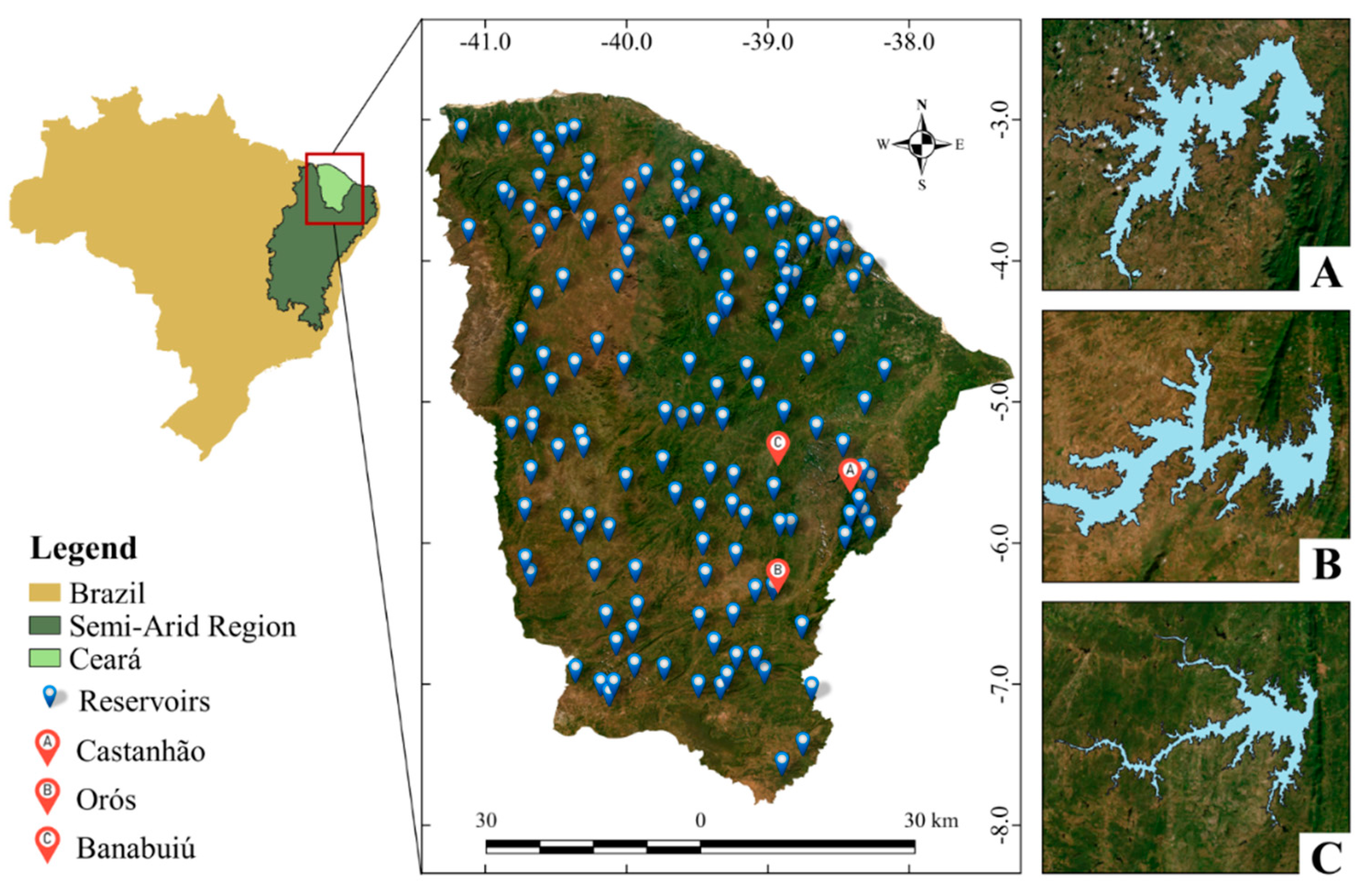
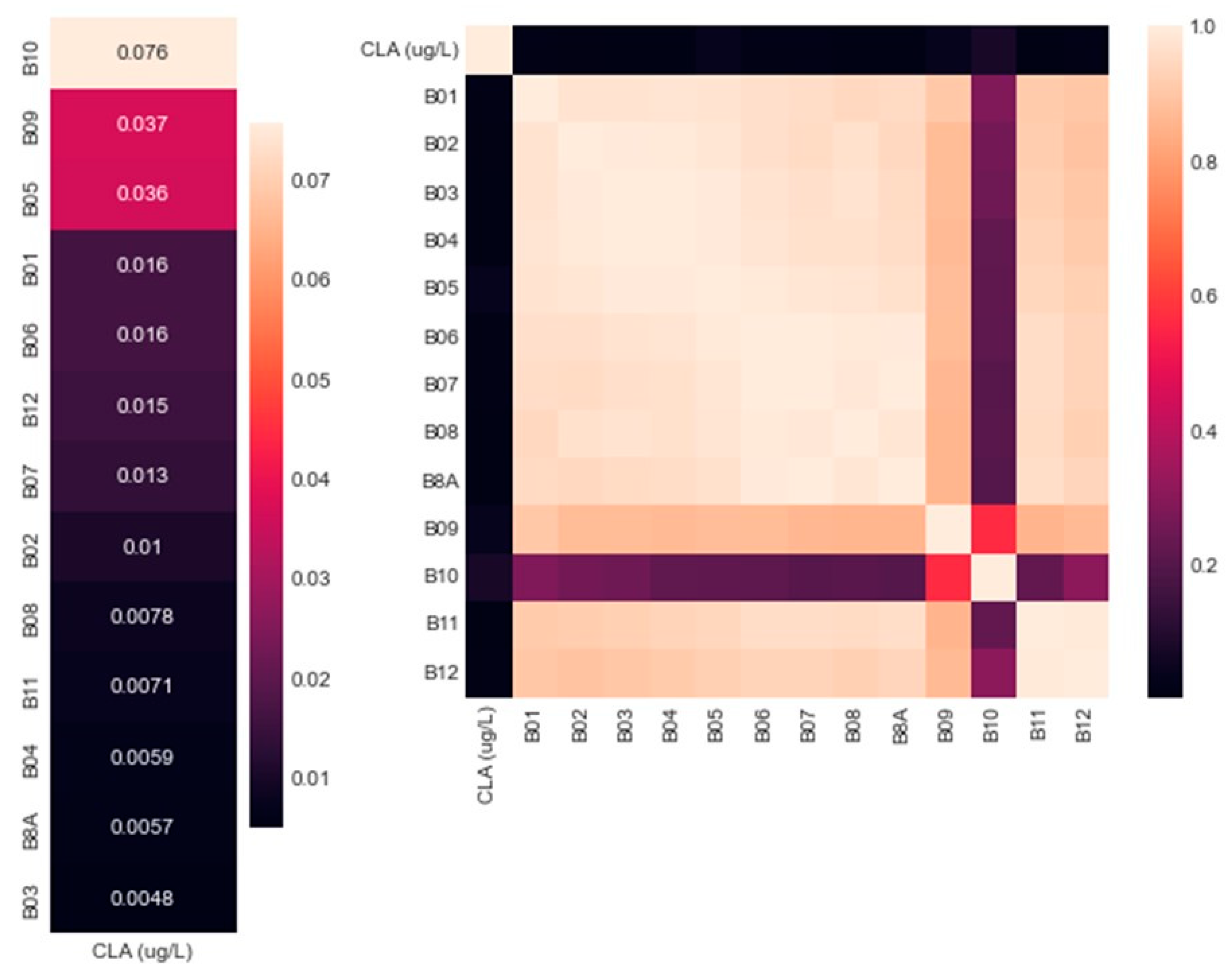
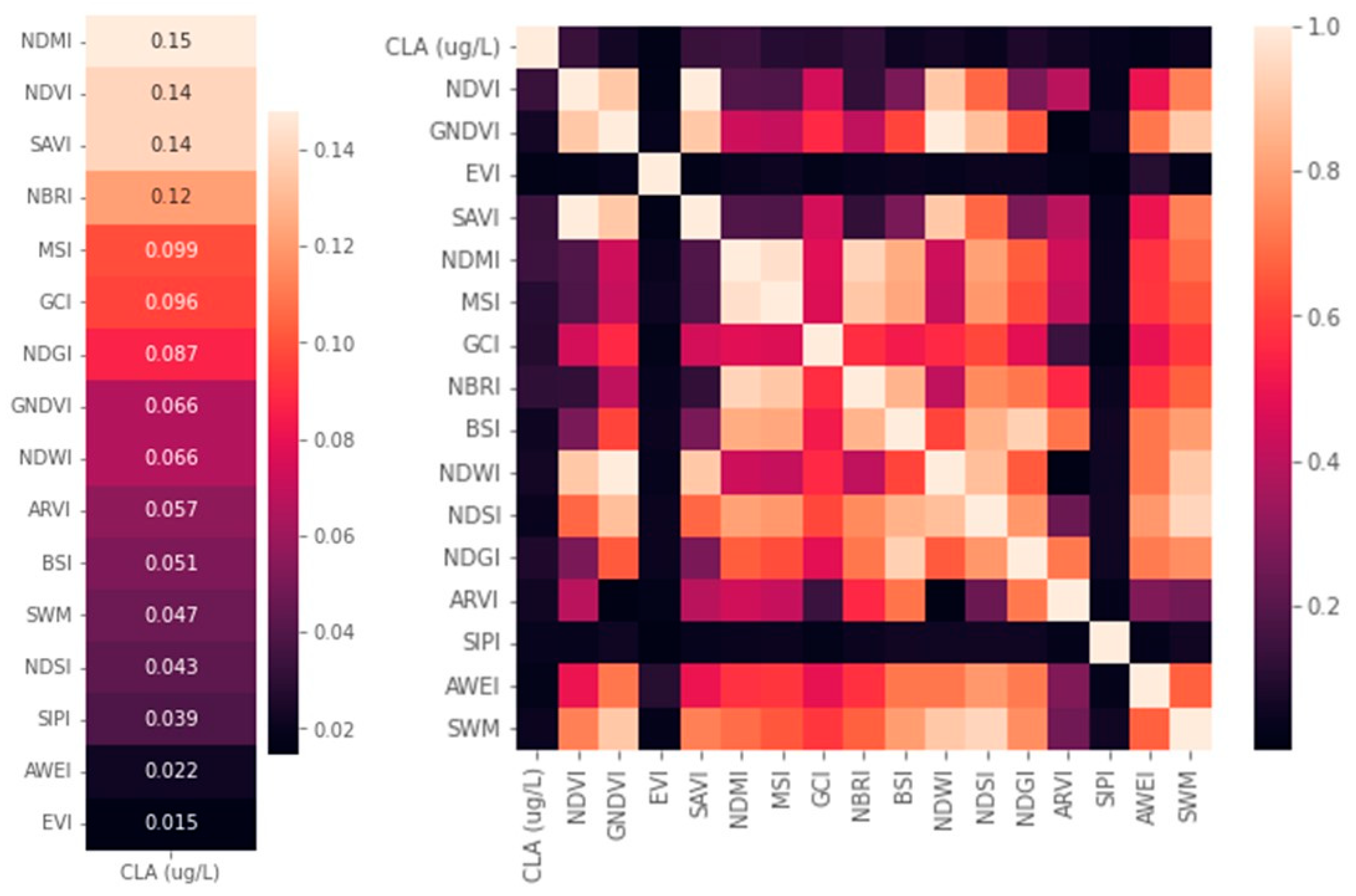
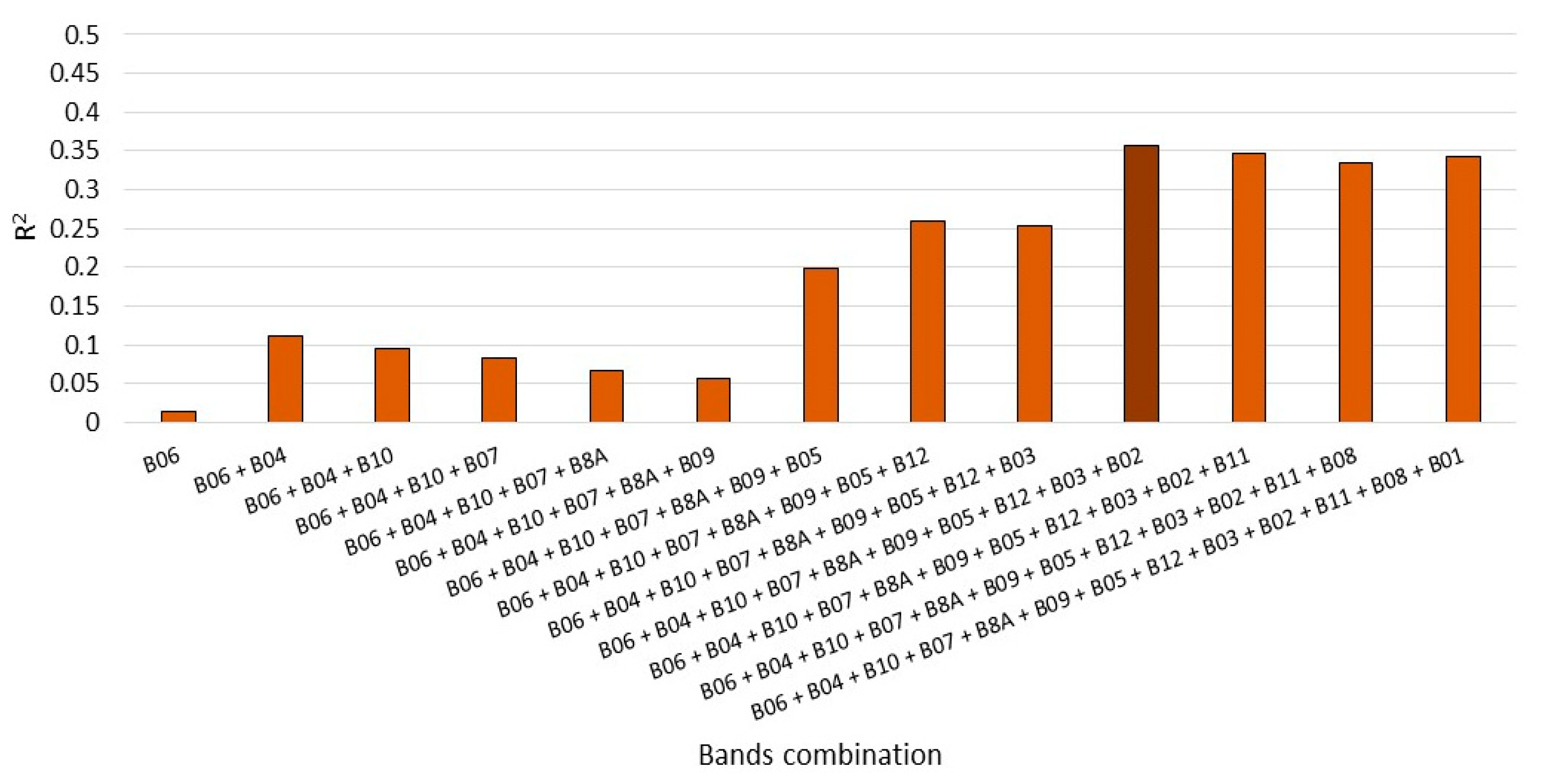
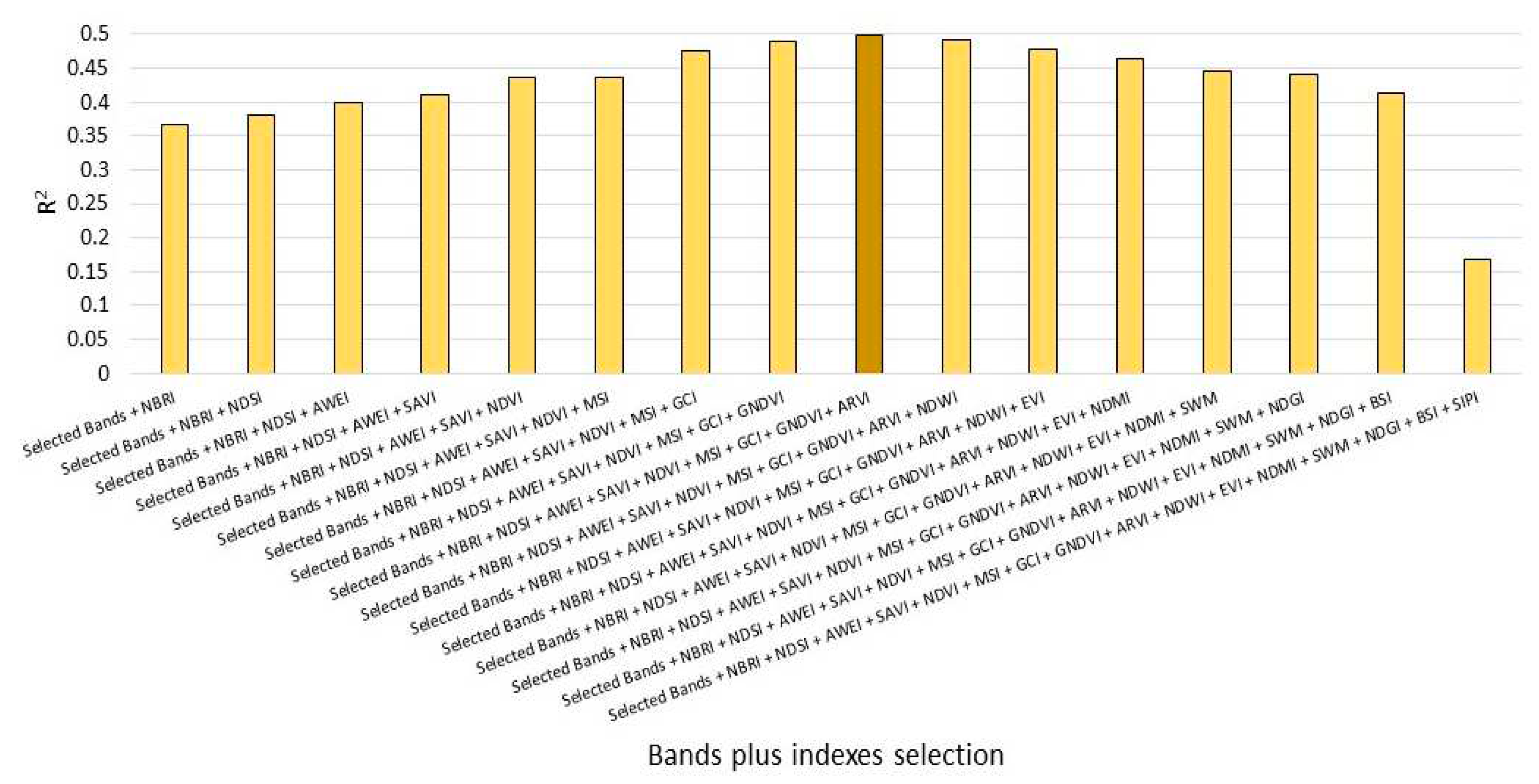
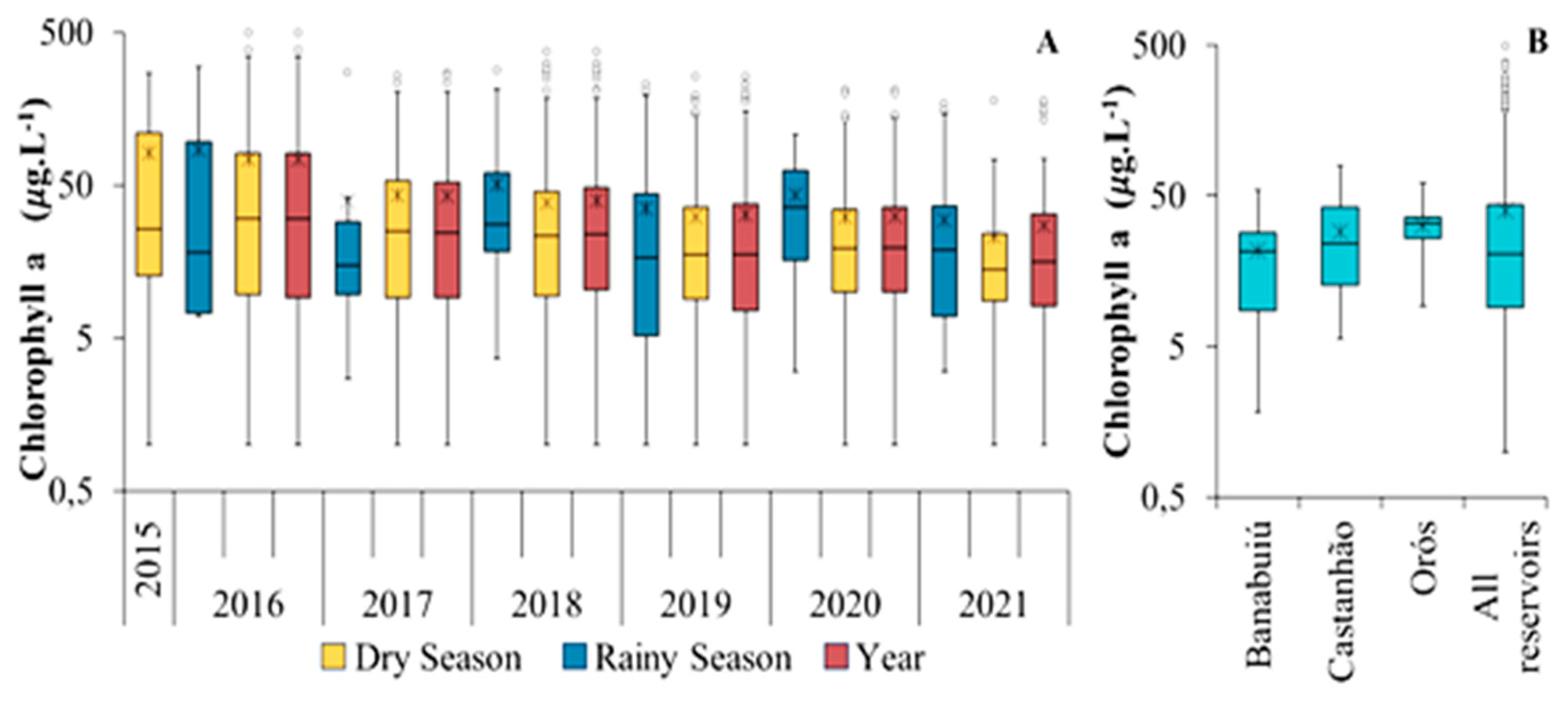
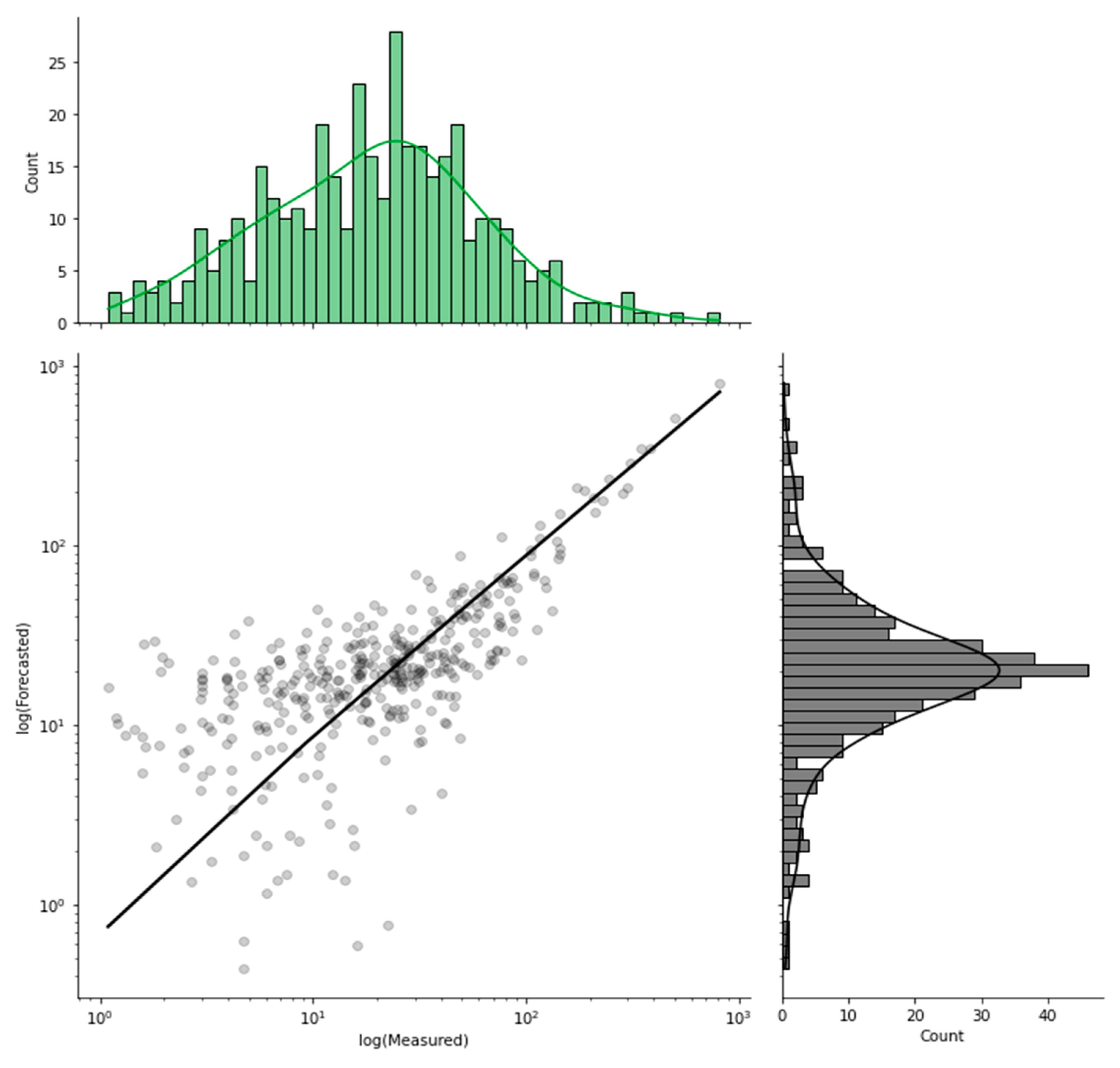
| Band | Central wavelength (nm) |
Band width (nm) |
Spatial resolution (m) |
Band spectral range |
|---|---|---|---|---|
| 1 | 443 | 20 | 60 | Coastal aerosol |
| 2 | 490 | 65 | 10 | Blue |
| 3 | 560 | 35 | 10 | Green |
| 4 | 665 | 30 | 10 | Red |
| 5 | 705 | 15 | 20 | Vegetation red edge 1 |
| 6 | 740 | 15 | 20 | Vegetation red edge 2 |
| 7 | 783 | 20 | 20 | Vegetation red edge 3 |
| 8 | 842 | 115 | 10 | NIR |
| 8A | 865 | 20 | 20 | Narrow NIR |
| 9 | 945 | 20 | 60 | Water vapor |
| 10 | 1380 | 30 | 60 | SWIR-Cirrus |
| 11 | 1610 | 90 | 20 | SWIR 1 |
| 12 | 2190 | 180 | 20 | SWIR 2 |
| Model | RMSE (μg/L) |
nRMSE (%) |
MAE (μg/L) |
MAPE (%) |
MBE (μg/L) |
R² | Yeo-Johnson Transformation |
|---|---|---|---|---|---|---|---|
| k-NN | 61.82 | 146.07 | 30.90 | 260.60 | -4.91 | 0.38 | Yes |
| XGBoost | 55.60 | 131.36 | 29.41 | 288.34 | -2.53 | 0.50 | No |
| RF | 56.75 | 134.10 | 29.92 | 311.58 | -1.54 | 0.48 | No |
| SVR | 50.64 | 119.64 | 25.07 | 182.60 | -6.97 | 0.58 | Yes |
| LASSO | 89.87 | 212.34 | 47.41 | 466.35 | -3.60 | 0.41 | Yes |
| GMDH | 20.38 | 53.20 | 14.09 | 102.34 | -4.86 | 0.91 | Yes |
| Model | RMSE (μg/L) |
MAE (μg/L) |
MBE (μg/L) |
R² |
|---|---|---|---|---|
| GMDH | 20.38 | 14.09 | -4.86 | 0.91 |
| Model | Location | Dataset | RMSE μg/L | R2 | Reference |
|---|---|---|---|---|---|
| Multimodal Deep Learning | Lake Simcoe, Canada | Sentinel-2 and Landsat-8 imagery | 60 |
0.92 | [147] |
| Convolutional Neural Network | Lake Balik, Turkey | Sentinel-2 imagery | 2.9 |
0.95 | [148] |
| Convolutional Neural Network | 11 Lakes in Karlsruhe, Germany | Simulated Chla data used for training, data from SpecWa used for evaluation | 12.4 |
0.82 | [149] |
| SVR | 45 Lakes across China | Sentinel-2 imagery | 6.3 | 0.88 | [150] |
| SVR | Buffalo Pound Lake, Canada | Sentinel-2 imagery | 13.9 |
0.66 | [151] |
| Toming’s index | A Baxe reservoir, Spain | Sentinel-2 imagery | 0.86 | [145] | |
| 3BSI index | 5 Reservoirs in Ceará, Brazil | Sentinel-2 imagery | 0.80 | [13] |
Disclaimer/Publisher’s Note: The statements, opinions and data contained in all publications are solely those of the individual author(s) and contributor(s) and not of MDPI and/or the editor(s). MDPI and/or the editor(s) disclaim responsibility for any injury to people or property resulting from any ideas, methods, instructions or products referred to in the content. |
© 2023 by the authors. Licensee MDPI, Basel, Switzerland. This article is an open access article distributed under the terms and conditions of the Creative Commons Attribution (CC BY) license (http://creativecommons.org/licenses/by/4.0/).





